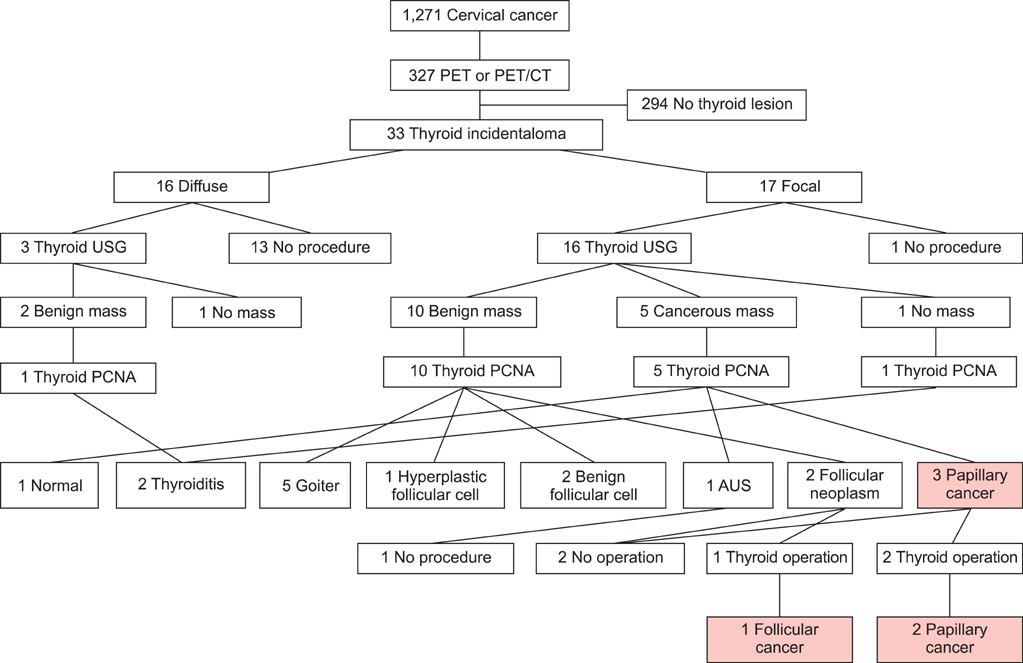J Gynecol Oncol.
2012 Jan;23(1):43-47. 10.3802/jgo.2012.23.1.43.
Characteristics of thyroid incidentalomas detected by pre-treatment [18F]FDG PET or PET/CT in patients with cervical cancer
- Affiliations
-
- 1Department of Obstetrics and Gynecology, Korea Cancer Center Hospital, Korea Institute of Radiological & Medical Sciences, Seoul, Korea. kidong.kim.md@gmail.com
- 2Department of Nuclear Medicine, Korea Cancer Center Hospital, Korea Institute of Radiological & Medical Sciences, Seoul, Korea.
- KMID: 2177513
- DOI: http://doi.org/10.3802/jgo.2012.23.1.43
Abstract
OBJECTIVE
Considering the increased use of [18F]FDG PET or PET/CT, the clinical significance of thyroid incidentalomas is the subject of controversy. The aim of this study was to determine the incidence of malignancies associated with thyroid incidentalomas detected by pre-treatment PET or PET/CT in patients with cervical cancer.
METHODS
We retrospectively reviewed the medical records of patients with cervical cancer who had thyroid incidentalomas detected by pre-treatment PET or PET/CT and were treated at our institute between January 2001 and December 2009.
RESULTS
Of 327 patients who underwent pre-treatment PET or PET/CT, 33 patients had thyroid incidentalomas (10.1%) and 4 patients were diagnosed with thyroid malignancies by percutaneous needle aspiration (PCNA) or surgery. To put it concretely, of 33 patients with thyroid incidentaloma, 16 patients had a diffuse uptake and 17 patients had a focal uptake. Four of 17 patients with focal uptake were diagnosed with thyroid malignancies (23.5%). One patient with a focal uptake had an atypical cell based on PCNA, but did not undergo additional studies. The mean SUVmax of thyroid malignancies did not differ from that of benign thyroid diseases.
CONCLUSION
Thyroid incidentalomas are frequently detected by pre-treatment PET or PET/CT in patients with cervical cancer. Focal uptake on PET or PET/CT has a high risk of thyroid cancer.
Keyword
MeSH Terms
-
Fluorodeoxyglucose F18
Humans
Incidence
Medical Records
Needles
Positron-Emission Tomography
Positron-Emission Tomography and Computed Tomography
Proliferating Cell Nuclear Antigen
Retrospective Studies
Thyroid Gland
Thyroid Neoplasms
Uterine Cervical Neoplasms
Fluorodeoxyglucose F18
Proliferating Cell Nuclear Antigen
Figure
Reference
-
1. Nakamoto Y, Tatsumi M, Hammoud D, Cohade C, Osman MM, Wahl RL. Normal FDG distribution patterns in the head and neck: PET/CT evaluation. Radiology. 2005. 234:879–885.2. Eloy JA, Brett EM, Fatterpekar GM, Kostakoglu L, Som PM, Desai SC, et al. The significance and management of incidental [18F]fluorodeoxyglucose-positron-emission tomography uptake in the thyroid gland in patients with cancer. AJNR Am J Neuroradiol. 2009. 30:1431–1434.3. Kang BJ, O JH, Baik JH, Jung SL, Park YH, Chung SK. Incidental thyroid uptake on F-18 FDG PET/CT: correlation with ultrasonography and pathology. Ann Nucl Med. 2009. 23:729–737.4. Rago T, Vitti P. Role of thyroid ultrasound in the diagnostic evaluation of thyroid nodules. Best Pract Res Clin Endocrinol Metab. 2008. 22:913–928.5. Cibas ES, Ali SZ. NCI Thyroid FNA State of the Science Conference. The Bethesda system for reporting thyroid cytopathology. Am J Clin Pathol. 2009. 132:658–665.6. Burguera B, Gharib H. Thyroid incidentalomas: prevalence, diagnosis, significance, and management. Endocrinol Metab Clin North Am. 2000. 29:187–203.7. Mazzaferri EL. Thyroid cancer in thyroid nodules: finding a needle in the haystack. Am J Med. 1992. 93:359–362.8. Cohen MS, Arslan N, Dehdashti F, Doherty GM, Lairmore TC, Brunt LM, et al. Risk of malignancy in thyroid incidentalomas identified by fluorodeoxyglucose-positron emission tomography. Surgery. 2001. 130:941–946.9. Kang KW, Kim SK, Kang HS, Lee ES, Sim JS, Lee IG, et al. Prevalence and risk of cancer of focal thyroid incidentaloma identified by 18F-fluorodeoxyglucose positron emission tomography for metastasis evaluation and cancer screening in healthy subjects. J Clin Endocrinol Metab. 2003. 88:4100–4104.10. Chen W, Parsons M, Torigian DA, Zhuang H, Alavi A. Evaluation of thyroid FDG uptake incidentally identified on PET/CT imaging. Nucl Med Commun. 2009. 30:240–244.11. Bae JS, Chae BJ, Park WC, Kim JS, Kim SH, Jung SS, et al. Incidental thyroid lesions detected by PET/CT: prevalence and risk of thyroid cancer. World J Surg Oncol. 2009. 7:63.12. Choi JY, Lee KS, Kim HJ, Shim YM, Kwon OJ, Park K, et al. Focal thyroid lesions incidentally identified by integrated 18F-FDG PET/CT: clinical significance and improved characterization. J Nucl Med. 2006. 47:609–615.13. Kim BH, Na MA, Kim IJ, Kim SJ, Kim YK. Risk stratification and prediction of cancer of focal thyroid fluorodeoxyglucose uptake during cancer evaluation. Ann Nucl Med. 2010. 24:721–728.
- Full Text Links
- Actions
-
Cited
- CITED
-
- Close
- Share
- Similar articles
-
- 18F-FDG PET/CT and Sonographic Findings of Thyroid Incidentalomas
- Use of 18F-FDG PET/CT in Second Primary Cancer
- Risk of Malignancy in Thyroid Incidentalomas Identified by Fluorodeoxyglucose-Positron Emission Tomography
- Accuracy of [ 18F ] FDG PET after Surgery and Radiotherapy in Head and Neck Cancers
- Characteristics and Detection Rate of Thyroidal Incidentaloma using ¹â¸F-FDG PET-CT


